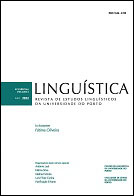Values and uses of the diminutive suffix "-inho" in European Portuguese and Brazilian Portuguese
Abstract
This study aims to revisit the essential dimensions of the suffix -inho in Portuguese, either in the European or in the Brazilian Portuguese, and analyzes some of the descriptions that have been made of them, in order to clarify (i) the systemic value of -inho in the word-formation network of the Portuguese language, and (ii) the values of use that it admits, due to several variables, such as: the nature of the base to which it connects, the intonation and the elocutive’s intensity with which it is used, the illocutionary intentionality of the speaker, the evaluative value to be transmitted, the formal, informal, ironic and situational context and message in which it occurs. It is important to differentiate the systemic values of the suffix from the values that the derivative in which it occurs conveys, due to the characteristics of the text and the linguistic situation in which it is used. In a text produced in ironic or sarcastic register, the whole message is permeated by these values, but it cannot be affirmed that the systemic value of the suffix is that of irony or sarcasm, classes that do not configure any derivational paradigm of Portuguese. Thus, besides to provide a categorization of the semantic-pragmatic values associated with the use of this suffix and to reanalyze some myths that persist in some of its descriptions, the elaboration of this text has also a pedagogical intention: to provide PL2 learners with an overview of the values and uses of the diminutive suffix -inho in Portuguese, that allows them to effectively use the suffix in their interaction with native speakers of Portugal or of Brazil.
References
Bacheschi, C. A. (2006). Os valores expressivos dos afixos na norma culta de São Paulo[Dissertação de Mestrado]. Pontifícia Universidade Católica de São Paulo (PUP-SP).
Booij, G. (2010). Construction morphology. Oxford University Press.
Booij, G. (2018). The Construction of Words: Advances in Construction Morphology. Springer.
Dębowiak, P. (2015). Os diminutivos no português europeu e no português do Brasil. Um estudo quantitativo. In R. Samartim, R. B. Vázquez, E. J. T. Feijó, & M. Brito-Semedo (Eds.), Estudos da AIL em Ciências da Linguagem: Língua, Linguística, Didática (pp. 175-184). Associação Internacional de Lusitanistas.
Jurafsky, D. (1993). Universals in the semantics of the diminutive. In J. S. Guenter; B.A: Kaiser, & C. C. Zoll (Eds.), Proceedings of the nineteenth annual meeting of the Berkeley Linguistics Society: general session and parasession on semantic typology and semantic universals (pp. 423-436). Berkeley Linguistics Society.
Jurafsky, D. (1996). Universal tendencies in the semantics of the diminutive.Language, 72(3), 533-578.
Lakoff, G., & Johnson, M. (1980). Metaphors We Live By. University of Chicago Press.
Maçãs, D. (1954-1955). O sufixo -inho junto a adjectivos na linguagem familiar. Boletín de Filología, (8), 219-232.
Rio-Torto, G. (1993). Formação de palavras em português. Aspectos da construção de avaliativos [Dissertação de Doutoramento]. Universidade de Coimbra. http://hdl.handle.net/10316/44237
Rio-Torto, G. (1997). Sistémica e pragmática dos sufixos avaliativos. Revista Portuguesa de Filologia, 21, 203-228.
Rio-Torto, G. (2022, no prelo), Peculiarities of Portuguese Word-Formation. In M. Loporcaro, & F. Gardani (Eds.), Oxford Research Encyclopedia of Linguistics. Oxford University Press. https://oxfordre.com/linguistics/page/romance-linguistics/
Rodrigues Lapa, M. (1984). Estilística da língua portuguesa (11ª ed., revista pelo autor). Coimbra Editora.
Rodrigues, A. S. (2015). A Gramática do Léxico Morfologia Derivacional e o Léxico Mental. Lincom Europa.
Santana, M. S. (2017). O sufixo diminutivo em português: forma, funcionamento e significação - do século XIII ao XX [Tese de Doutoramento]. Universidade de São Paulo.
Sifianou, M. (1992). The use of diminutives in expressing politeness: Modern Greek versus English. Journal of Pragmatics, 17(2), 155-173.
Silva, A. S. (2006). A estrutura semântica do diminutivo em português. In C. Maia, A. C. M. Lopes, & G. Rio-Torto (Org.), Miscelânea de estudos in memoriam José G. Herculano de Carvalho (pp. 485-509). Faculdade de Letras da Universidade de Coimbra, Instituto de Língua e Literatura Portuguesa.
Silva, J. T., & Silva, W. P. (2021). Patemização em anúncios publicitários: uma análise morfopragmática das construções X-inho e X-ão. A cor das letras (Revista Digital dos Programas de Pós-Graduação do Departamento de Letras e Artes da UEFS Feira de Santana), 22(1), 137-164.
Skorge, S. (1959). Os sufixos diminutivos em português. Centro de Estudos Filológicos.
Squarisi, D. (2018, agosto 12). Diminutivo: conotação e plural. Correio Braziliense. https://blogs.correiobraziliense.com.br/dad/diminutivo-conotacao-e-plural/
Valentim, H. T., & Gonçalves, M. (2021).A intensificação em Português Europeu – algumas configurações linguísticas em comentários em linha.Estudios Románicos, 30, 103-120.
Wilson, D. (2006). The pragmatics of verbal irony: Echo or pretence? Lingua, 116(10), 1722-1743.
Downloads
Published
Issue
Section
License
Copyright (c) 2022 Linguística: Revista de Estudos Linguísticos da Universidade do Porto

This work is licensed under a Creative Commons Attribution-NonCommercial 4.0 International License.



